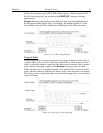
74 PIXIS System Manual Version 2.C
Fast and Safe Modes
Introduction
The PIXIS has been designed to allow the greatest possible flexibility when
synchronizing data collection with an experiment. The fundamental difference between
the Fast and Safe modes is how often the acquisition start and acquisition stop commands
are sent by the computer for a data collection sequence. With Safe Mode, the computer
sends a start and a stop command for each frame of a data sequence. With Fast Mode,
the computer sends only one start and one stop command for each data sequence. Once
the start command is sent, the selected timing mode and the shutter condition determine
when charge will be allowed to fall on the CCD array.
In WinX, the choice of Fast or the Safe data collection is made on the Experiment
Setup|Timing tab. The flowcharts in Figure 36 show the differences between the two
modes. In LightField, Fast data collection is always used.
Fast Mode (WinX and LightField)
In Fast operation, the PIXIS runs according to the timing of the experiment, with no
interruptions from the computer. Fast operation is primarily for collecting "real-time"
sequences of experimental data, where timing is critical and events cannot be missed.
Once the PIXIS is sent the start command by the computer, all frames are collected
without further intervention from the computer. The advantage of this timing mode is that
timing is controlled completely through hardware. A drawback to this mode is that the
computer will only display frames when it is not performing other tasks. Image display
has a lower priority, so the image on the screen may lag several images behind. A second
drawback is that a data overrun may occur if the number of images collected exceeds the
amount of allocated RAM or if the computer cannot keep up with the data rate.
Note: LightField always uses Fast Mode.
Safe Mode (WinX)
Safe Mode operation is useful when the camera is operated from a slower computer that
cannot process the incoming data fast enough. It is also useful when data collection must
be coordinated with external devices such as external shutters and filter wheels. As seen
in Figure 36, in Safe Mode operation, the computer controls when each frame is taken.
After each frame is received, the camera sends the Stop Acquisition command to the
camera, instructing it to stop acquisition. Once that frame is completely processed and
displayed, another Start Acquisition command is sent from the computer to the camera,
allowing it to take the next frame. Display is therefore, at most, only one frame behind
the actual data collection. One disadvantage of the Safe mode is that events may be
missed during the experiment, since the PIXIS is disabled for a short time after each
frame.
Note: When running WinX, Safe Mode must be used whenever the system is set up for
the optional Kinetics Readout Mode. See “Kinetics Mode” (page 77) for more
information about this type of image acquisition and readout.


















